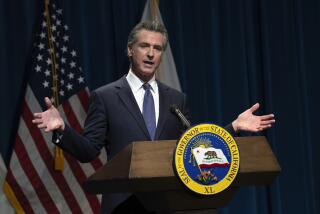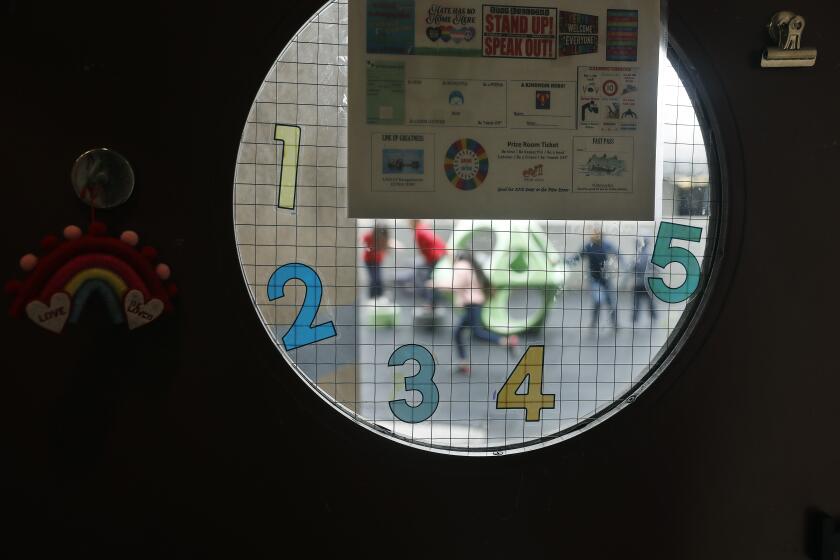$7.5-Billion State Budget Gap Forecast : Finances: Analyst blames weak economy and repeal of taxes in newest prediction of shortfall. Renewed battle between Wilson and Legislature next year is likely.
California’s stubbornly downtrodden economy and decisions made by voters and policy-makers will combine to confront Gov. Pete Wilson and state lawmakers with a budget shortfall of $7.5 billion next year, the nonpartisan legislative analyst said Thursday in a new gloomy forecast.
The report by Legislative Analyst Elizabeth Hill was the second out of Sacramento in as many months confirming that the budget agreement reached by Wilson and the Legislature at the end of a bitter summer-long stalemate has failed to stem the flow of red ink from the state’s bottom line.
And it shows that without an economic miracle the state will face a budget shortfall next spring for the fourth consecutive year. The shortfall probably will renew the battle over tax increases and spending cuts that has gripped the Capitol since 1990.
Hill predicted that the state will end this fiscal year June 30 with a $2.7-billion deficit in its $40.8-billion general fund budget. At the same time, the Legislature will be drafting the budget for the next fiscal year. It is that budget that will be at least $7.5 billion out of balance if lawmakers do not cut spending or if an improved economy and higher taxes do not bring in more revenue, Hill said.
The biggest culprit is the California economy, which Hill forecasts would produce $5 billion less in state tax revenue than the governor and Legislature anticipated for the two-year period that ends June 30, 1994.
Other factors cited are the scheduled repeal of one-half cent of the state’s sales tax, worth $1.5 billion; a $300-million tax break for business that was suspended but is due to reappear next year, and the voters’ decision Nov. 3 to repeal the so-called snack tax, a move that will cost the state $540 million over two years.
Speaking for the Wilson Administration, Finance Director Thomas Hayes said the report showed that worldwide economic restructuring has significantly affected the state’s revenue.
But Hayes also said that in addition to the recession the state has “self-inflicted wounds” that inhibit economic growth.
“The most important thing we can do to help improve our revenue situation is to create a better climate for job creation and retention by lowering the cost of doing business here in California,” Hayes said in a statement.
Senate Leader David A. Roberti (D-Van Nuys) described the numbers as “staggering” and suggested that the temporary portion of the sales tax would have to remain in place.
Hill’s estimate of the shortfall was higher than the $4.1-billion gap projected by the Commission on State Finance in October. But the higher number did not necessarily stem from a decline in the economic outlook.
Most of the difference in the predictions was because of the repeal of the snack tax, Hill’s inclusion of a 3% inflation adjustment for some state programs, and her assumption that the state would keep its pledge--not required by law--to give the public schools the same dollars per student next year that they are receiving this year.
Hill noted that there are 120,000 fewer people working than projected by the Wilson Administration in the revenue estimates on which the state budget was balanced. The estimates were made in May and were not changed, even though the budget was not enacted until Sept. 2--two months into the fiscal year.
Tracking the predicted budget gap as it grows has become an annual ritual in Sacramento since 1990, when then-Gov. George Deukmejian and the Legislature faced a projected shortfall of $3.6 billion.
In 1991, when Wilson took office, he estimated the shortfall at $7 billion, but within a few months it had grown to $14.3 billion. This year, the projected budget gap was $10.7 billion.
These recurring gaps are not the same as year-end deficits, which measure the difference between what the state actually took in and what it spent. The shortfalls are tentative estimates of what the deficit would be at year’s end if the governor and Legislature did nothing to change the situation.
Each year since 1990, when employment in California peaked, the governor and Legislature have erased the gaps on paper and balanced the budget in part by assuming that the recession would be shorter and shallower than it has turned out to be.
In 1991, policy-makers tried to make the gap disappear with a $7.5-billion tax increase, about $3 billion in spending cuts and a collection of fund shifts and bookkeeping maneuvers. This year, Wilson opposed attempts to raise taxes again and instead pushed for cuts in health, welfare, local government and higher education programs and forced elementary and high schools to borrow from future funds to keep pace with growing enrollment.
But each year, as the economy has continued to sputter, revenues have fallen short of projections and the gaps have reappeared.
Most fiscal experts agree that this trend will continue until the economy turns around.
“At the core of the problem is the weak California economy,” said Kevin Scott, executive director of the Commission on State Finance. “It will be very difficult to balance our budget so long as the economy continues to flounder.”
Although Hill declined to offer any suggestions for closing the budget gap, she urged lawmakers and the governor to put “everything on the table,” including tax increases.
“It’s too early for folks to paint lines in the sand on what they will or will not accept,” she said.
Wilson said last week that he did not intend to seek a continuation of the temporary sales tax and told reporters he would be delighted to see it expire on schedule. Aides said later that Wilson’s comments did not mean that he had ruled out the option of keeping the sales tax on the books.
Roberti said the sales tax revenue would be crucial to keeping the state’s commitment to the schools that per-pupil funding would remain at its current level.
“Anything short of this would be irresponsibly destructive to our public schools and even more destructive to (businesses) that demand an educated work force,” he said.
More to Read
Get the L.A. Times Politics newsletter
Deeply reported insights into legislation, politics and policy from Sacramento, Washington and beyond. In your inbox three times per week.
You may occasionally receive promotional content from the Los Angeles Times.






